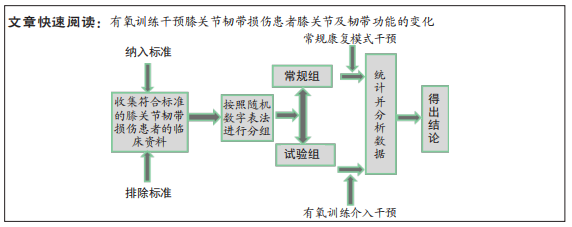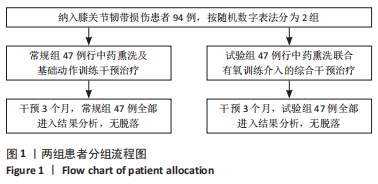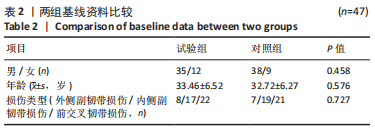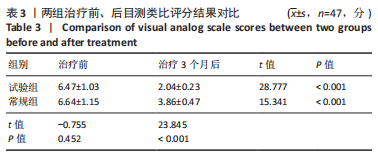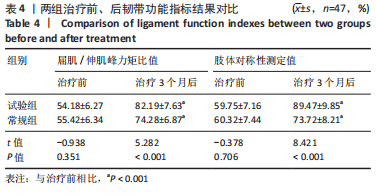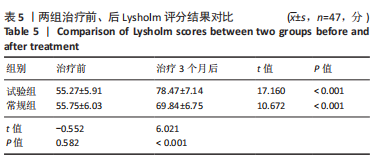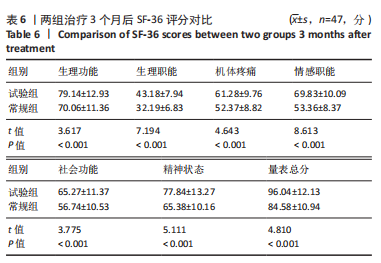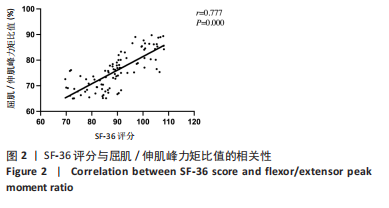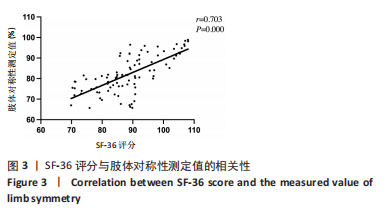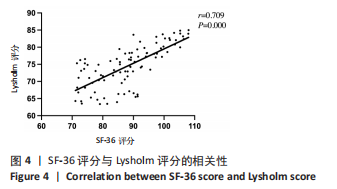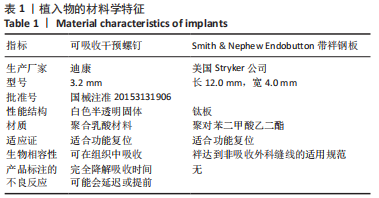[1] 郑峒,李旭,洪雷,等.前交叉韧带撕裂合并外侧半月板后角根部损伤导致膝关节高度前外旋转不稳定[J].中国运动医学杂志,2019, 38(8):643-651.
[2] 罗鸿,刘方,李顺华,等.步态分析应用在前交叉韧带损伤诊断中的意义[J].中国组织工程研究,2019,23(31):4969-4973.
[3] ESSILFIE AA, ALAIA EF, BLOOM DA, et al. Distal posterolateral corner injury in the setting of multiligament knee injury increases risk of common peroneal palsy. Knee Surg Sports Traumatol Arthrosc. 2021; 30(1):239-245.
[4] GRASSI A, AGOSTINONE P, PAOLO SD, et al. Knee position at the moment of bone bruise could reflect the late phase of non-contact anterior cruciate ligament injury rather than the mechanisms leading to ligament failure. Knee Surg Sports Traumatol Arthrosc. 2021; 29(12):4138-4145.
[5] 刘晓磊,章耀华,郭恒冰,等.本体觉促进训练对前交叉韧带重建术后患者膝关节功能和姿势控制的效果[J].中国康复理论与实践, 2019,25(4):472-475.
[6] 许善补,黎华茂,张红才.运动疗法联合臭氧治疗膝关节前交叉韧带损伤临床疗效[J].临床军医杂志,2019,47(11):1200-1203.
[7] 丘志康,安彦伟.长期低强度有氧运动对中老年韧带松弛恢复状况影响的研究[J].科学技术与工程,2017,17(12):147-151.
[8] 李涛,裴建祥,宋奇志.膝关节骨关节炎保守治疗近期疗效的影响因素[J].临床与病理杂志,2019,39(7):1476-1480.
[9] 中国中西医结合学会骨伤科分会.外踝韧带损伤的中西医结合治疗专家共识[J].中华骨科杂志,2019,39(11):653-659.
[10] SAMMA L, RASJAD C, SEWENG A, et al. Correlation between Body Mass Index(BMI),Visual Analogue Scale(VAS)score and knee osteoarthritis grading. Med Clín Práctica. 2021;26(11):851-856.
[11] 刘志成,李雁,张其亮.前交叉韧带重建后膝关节周围屈伸肌力与运动功能的变化[J].中国组织工程研究,2018,22(27):4393-4399.
[12] BRIGGS KK, LYSHOLM J, TEGNER Y, et al. The Reliability,Validity,and Responsiveness of the Lysholm Score and Tegner Activity Scale for Anterior Cruciate Ligament Injuries of the Knee. Am J Sports Med. 2017;37(5):890-897.
[13] 张蓉, 孙芸.社区高血压患者自我管理状况与生活质量的相关性分析[J]. 解放军护理杂志,2014,31(4):27-30.
[14] 兰敏,聂思,廖新根,等.早期关节镜辅助一期重建膝关节多韧带损伤的重要性[J].中国内镜杂志,2020,26(3):13-16.
[15] 吴博, 张雷, 庞文君,等. 全身振动训练对前交叉韧带损伤重建术后患者下肢运动控制的影响[J]. 中国康复医学杂志,2016,31(4): 421-425.
[16] 杨雪捷,张鹏翼,李巍,等.强筋健骨活血汤结合针灸疗法促进膝关节前交叉韧带损伤临床康复效果观察[J].中华中医药学刊,2021, 39(5):44-47.
[17] 王健,王永健,王海军,等.长病程前交叉韧带损伤后膝关节继发改变研究[J].中国运动医学杂志,2019,38(4):276-280.
[18] 黄锡豪,李韬,赵廷崴,等.基于华西分期分型诊治体系治疗膝关节多发韧带损伤脱位的疗效研究[J].中国修复重建外科杂志,2022, 36(1):1-9.
[19] 宋关阳,张辉,冯华.前十字韧带损伤后胫骨过度前移对重建术后膝关节稳定性的影响[J].中华骨科杂志,2019,39(7):392-397.
[20] 毛云鹤,唐婕晞,李箭,等.穿骨原位缝合修复前交叉韧带技术在膝关节多发韧带损伤脱位中的应用[J].中国修复重建外科杂志, 2020,34(2):190-195.
[21] 易贤楚,俎志勇,冯彦辉,等.本体觉运动疗法联合高压氧对膝关节交叉韧带损伤术后康复效果的影响[J].中华航海医学与高气压医学杂志,2021,28(1):34-38.
[22] 陈柯,张杰敏,张馨梅,等.阶段性系统康复锻炼在膝关节前交叉韧带损伤重建术后的应用效果[J].西部医学,2016,28(4):560-563.
[23] 鲁智勇,普江艳,解强,等.改良运动损伤预防方案在前交叉韧带损伤预防中的应用[J].中国康复医学杂志,2021,36(4):388-397.
[24] 祝叶,舒晴,余达蔚,等.基于神经肌肉控制理论探讨本体感觉与前交叉韧带损伤的关系[J].华西医学,2022,37(5):688-692.
[25] 杨春琴,李玲霞,王明明,等.有氧运动配合核心肌群训练对脊髓损伤患者心肺功能及下肢肌力的影响[J].河北医学,2022,28(1):86-91.
[26] 张秋阳,钱贞,李瑾,等. 四肢联动在脊髓损伤患者心肺功能评
估中的可行性研究[J]. 实用心脑肺血管病杂志,2019,27(11):
16-20.
[27] 左雄伟,曾霞.运动对膝关节前交叉韧带损伤患者自我效能水平及Lysholm膝功能评分的影响[J].检验医学与临床,2018,15(A01):48-50.
[28] 张挥武,刘蓓,赵大仁,等.中药外敷结合运动疗法治疗膝关节内侧副韧带损伤的临床疗效观察[J].中国运动医学杂志,2020, 39(7):531-534.
[29] 杨雪,周云,丁呈彪,等.跑台运动结合认知训练对膝关节韧带损伤患者膝关节功能和恐动心理的影响[J].中国伤残医学,2020, 28(10):13-16.
[30] 蔡立柏,刘延锦,崔妙然,等.全膝关节置换术恐动症患者术后早期功能锻炼体验的质性研究[J].中华护理杂志,2019,54(11):1663-1668.
[31] PAN H, ZHANG P, ZHANG Z, et al. Arthroscopic partial meniscectomy combined with medical exercise therapy versus isolated medical exercise therapy for degenerative meniscal tear: A meta-analysis of randomized controlled trials. Int J Surg. 2020;79:222-232.
[32] EITZEN I, MOKSNES H, SNYDER-MACKLER L, et al. A progressive 5-week exercise therapy program leads to significant improvement in knee function early after anterior cruciate ligament injury. J Orthop Sports Phys Ther. 2010;40(11):705-721.
[33] STENSRUD S, RISBERG MA, ROOS EM. Effect of exercise therapy compared with arthroscopic surgery on knee muscle strength and functional performance in middle-aged patients with degenerative meniscus tears: a 3-mo follow-up of a randomized controlled trial. Am J Phys Med Rehabil. 2015;94(6):460-473.
[34] DARGO L, ROBINSON KJ, GAMES KE. Prevention of Knee and Anterior Cruciate Ligament Injuries Through the Use of Neuromuscular and Proprioceptive Training: An Evidence-Based Review. J Athl Train. 2017; 52(12):1171-1172.
[35] FILBAY SR, ROOS EM, FROBELL RB, et al. Delaying ACL reconstruction and treating with exercise therapy alone may alter prognostic factors for 5-year outcome: an exploratory analysis of the KANON trial. Br J Sports Med. 2017;51(22):1622-1629.
[36] PATTERSON BE, BARTON CJ, CULVENOR AG, et al. Exercise-therapy and education for individuals one year after anterior cruciate ligament reconstruction: a pilot randomised controlled trial. BMC Musculoskelet Disord. 2021;22(1):64.
[37] STENSRUD S, ROOS EM, RISBERG MA. A 12-week exercise therapy program in middle-aged patients with degenerative meniscus tears: a case series with 1-year follow-up. J Orthop Sports Phys Ther. 2012; 42(11):919-931
[38] LEPLEY LK, WOJTYS EM, PALMIERI-SMITH RM. Combination of eccentric exercise and neuromuscular electrical stimulation to improve quadriceps function post-ACL reconstruction. Knee. 2015;22(3):270-277. |
